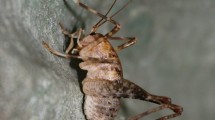Summary
-
1.
The two single slit sensilla on the pretarsus of the spider leg (Cupiennius salei Keys.) are vibration sensitive. Due to their arrangement they are also stimulated effectively by active downward movement of the pretarsus which may result from muscular activity directly or from an increase of the hemolymph pressure (Figs. 1, 2, 3).
-
2.
The slits are not tuned to a restricted frequency range. Their threshold displacement was determined electrophysiologically from 0.01 Hz to 1 kHz and found to be higher than in the slits of the metatarsal organ by roughly two orders of magnitude. The threshold decreases only slightly up to about 40 Hz but much more steeply at higher frequencies. The minimal threshold value for displacement within the tested frequency range was found at 1 kHz and measured 2 × 10−5 cm. The minimal threshold value for acceleration found at 0.01 Hz was 0.3 × 10−9 cm/s2 (Fig. 4a). Thresholds vary with different preset tensions in the cuticle surrounding the slits (Fig. 5).
-
3.
The shapes of the threshold curves are similar for dorsoventral and lateral displacement of the pretarsus (Fig. 4b). Values for lateral displacement are at most 3 dB higher than those for dorsoventral displacement.
-
4.
As in other slit sensilla the frequency response of the pretarsal slits follows a power functiony(f) =f k (Fig. 7). The constantk varies between 0.39 and 0.44, reflecting receptor properties intermediate between those of a frequency-independent amplitude receptor (k = 0) and those of a velocity receptor (k = 1). Beyond 10 Hz the response of the receptor saturates. Phase locking between stimulus and response is observed up to about 100 Hz (stimuli 10 dB above threshold).
Similar content being viewed by others
References
Barth FG (1967) Ein einzelnes Spaltsinnesorgan auf dem Spinnentarus: seine Erregung in Abhängigkeit von den Parametern des Luftschallreizes. Z Vergl Physiol 55:407–449
Barth FG (1972a) Die Physiologie der Spaltsinnesorgane. I. Modellversuche zur Rolle des cuticularen Spaltes beim Reiztransport. J Comp Physiol 78:315–336
Barth FG (1972b) Die Physiologie der Spaltsinnesorgane. II. Funktionelle Morphologie eines Mechanorezeptors. J Comp Physiol 81:159–186
Barth FG (1981) Strain detection in the arthropod exoskeleton. In: Laverack MS, Cosens D (eds) Sense organs. Blackie, Glasgow, pp 112–141
Barth FG, Geethabali (1982) Spider vibration receptors: Threshold curves of individual slits in the metatarsal lyriform organ. J Comp Physiol 148:175–185
Barth FG, Libera W (1970) Ein Atlas der Spaltsinnesorgane vonCupiennius salei Keys. Chelicerata (Araneae). Z Morphol Ökol Tiere 68:343–368
Barth FG, Seyfarth E-A (1979)Cupiennius salei Keys. (Araneae) in the highlands of central Guatemala. J Arachnol 7:255–263
Barth FG, Stagl J (1976) The slit sense organs of Arachnids. A comparative study of their topography on the walking legs (Chelicerata, Arachnida). Zoomorphologie 86:1–23
Bohnenberger J (1981) Matched transfer characteristics of single units in a compound slit sense organ. J Comp Physiol 142:391–402
Foelix RF (1970) Structure and function of tarsal sensilla in the spiderAraneus diadematus. J Exp Zool 175:99–124
Frank H (1957) Untersuchung zur funktionellen Anatomie der lokomotorischen Extremitäten vonZygiella-x-notata, einer Radnetzspinne. Zool Jahrb Abt Anat Ontog Tiere 76:423–460
Heinzel HG (1978) Aerodynamische, mechanische und elektrophysiologische Untersuchung der Heuschreckenantenne als Luftströmungssinnesorgan. Dissertation, Universität Düsseldorf
Hener T (1976) Spaltsinnesorgane und Vibrationssinn beim Beutefang der SpinneCupiennius salei Keys. Diplomarbeit, Universität München
Klärner D, Barth FG (1982) Vibratory signals and prey capture in orb-weaving spiders (Zygiella x-notata, Nephila clavipes; Araneidae). J Comp Physiol (in press)
Liesenfeld FJ (1956) Untersuchungen am Netz und über den Erschütterungssinn vonZygiella-x-notata (Araneidae). Z Vergl Physiol 38:563–592
Liesenfeld FJ (1961) Über Leistung und Sitz des Erschütterungssinnes von Netzspinnen. Biol Zentralbl 80:465–475
Loewe R, Linzen B, Stackelberg W von (1970) Die gelösten Stoffe in der Haemolymphe einer Spinne,Cupiennius salei Keys. Z Vergl Physiol 66:27–34
Mann DW, Chapman KM (1975) Component mechanisms of sensitivity and adaptation in an insect mechanoreceptor. Brain Res 97:331–336
Masters MW, Markl H (1981) Vibration signal transmission in spider orb webs. Science 213:363–365
Melchers M (1963) Zur Biologie und zum Verhalten vonCupiennius salei, einer amerikanischen Ctenide. Zool Jahrb Abt Syst Oekol Geogr Tiere 91:1–90
Ruhland M, Rathmayer W (1978) Die Beinmuskulatur und ihre Innvervation bei der VogelspinneDugesiella hentzi (Ch.) (Araneae, Aviculariidae). Zoomorphologie 89:33–46
Seyfarth E-A (1978) Lyriform slit sense organs and muscle reflexes in the spider leg. J Comp Physiol 125:45–57
Thorson J, Biederman-Thorson M (1974) Distributed relaxation processes in sensory adaptation. Science 183:161–172
Vogel H (1923) Über die Spaltsinnesorgane der Radnetzspinnen. Jena Z Med Naturwiss 59:171–208
Walcott C, Kloot WG van der (1959) The physiology of the spider vibration receptor. J Exp Zool 141:191–244
Author information
Authors and Affiliations
Rights and permissions
About this article
Cite this article
Speck, J., Barth, F.G. Vibration sensitivity of pretarsal slit sensilla in the spider leg. J. Comp. Physiol. 148, 187–194 (1982). https://doi.org/10.1007/BF00619125
Accepted:
Issue Date:
DOI: https://doi.org/10.1007/BF00619125




